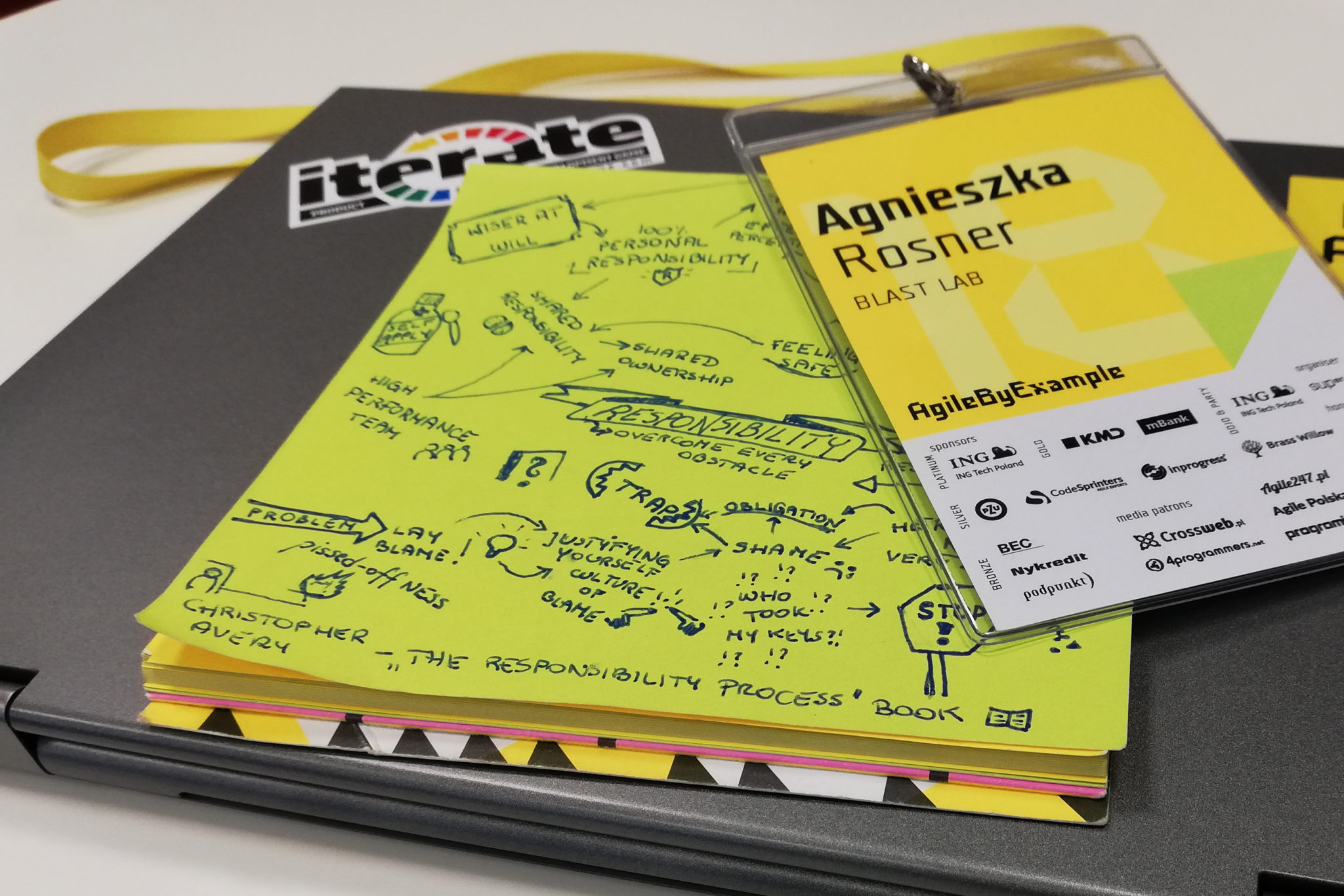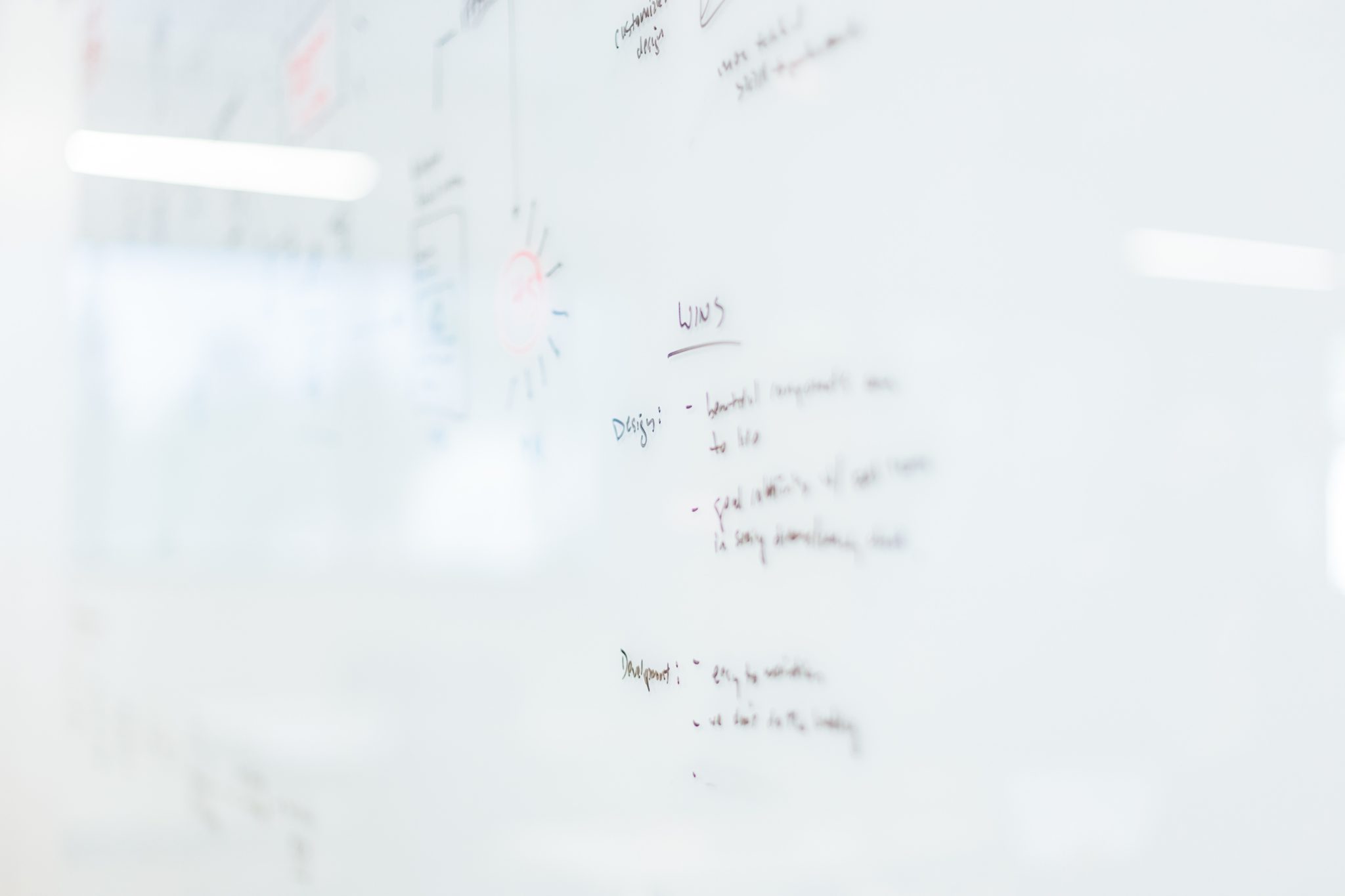Since Agile is a popular topic, the number of books, articles and events increases everyday. It gives us a wide spectrum of opportunities to acquire new knowledge. Regardless of the position you have, you once might have thought: so little time, so much to read. Therefore I decided to get familiar with the most valuable content and meet the most interesting people at this year’s AgileByExample conference in Warsaw.
And as you can suppose I am not disappointed.
Three days spent in a full agile immersion gave me a serious inspection of my previous experience and work style. I came back with a head full of insights and inspirations. If you are wondering how the insights, which I acquired I am going to implement in my everyday work – this article is exactly for you.
There is no better way to learn something than to experience it.
The first day of AbE, the workshop called dojo was a great opportunity to TRY something in person. ITERATE™ game made a great impression on me. Tomek Włodarek and Kamil Surmacz led workshop, during which we had the opportunity to play their proprietary boardgame. It turned out to be extremely revealing. In an environment separated from my everyday work, I got to a group of three Scrum Masters. We were required to play roles that we do not perform on a daily basis. The demanding rules of the game, unsteady conditions, which very realistically reflect the realities of working in Scrum and the desire to win – all of these were like a bulls-eye.

The basics of Scrum remebered through a game.
Moreover, the emotions accompanying the game and the awareness of “nothing to lose” allowed us to observe ourselves in action. With pure curiosity and freedom to experiment we were encouraged to return to the basics of Scrum. One of the most interesting insights after the workshop was the fact that in the game we could directly observe the growing PO’s stress level and the decrease of the team’s flow. In our everyday work, we are not able to openly notice these aspects on the meter even though they have a real impact on the team’s performance. I would like to build a general awareness of responsibility in the team. Not only have these factors on my mind.
I need to mention Tomek Włodarek again. His light talk about the main areas of Scrum Master’s interest allowed me to do a proper soul searching. In the atmosphere of inspiration and motivation, accompanying the conferences buzz and omnipresent success stories, it is important to stop for a moment and think: How do I deal with all of the mentioned issues?
Tomek has identified 6 lenses through which the Scrum Master can look at his work:
1. Scrum
The field in which we must achieve mastery, we have to be the experts and the role models. So I need to ask myself: when was the last time I looked at the Scrum Guide? Do I only know agile methodologies or also have an agile mindset?
2. People
The team, the individuals I work with, and finally myself. Who they are? What are the values that we share? What motivates us? During her lecture, Melissa Lang also reminded us of the need to really get to know people we are working with. Not through escapades, not through games but through conversation, finding common values and expectations, shared experiences and find the fields in which we can complement each other. Every retrospective doesn’t need to concer the insights of the last sprint. The time spent building a team can result in as much or better.
3. Business/product
Curiosity, openness, having business value in mind. For me, it should be so much easier because I started my adventure in Scrum as a Product Owner. Are my interests in the product and the customer still strong? Do the Scrum Team members other than PO have the client and the value they provide him in mind?
4. Project
Who our stakeholders are? How does PO cooperate with them? We need curiosity in these areas to be able to ask good questions, to have a broad perspective, that allows us to see problems that lie beneath the surface and are not just the tip of the iceberg.
5. Software engineering
There is no necessity for Scrum Masters to be software engineering specialists, but we spend our time at work with people who deal with it directly. We should show curiosity and interest to have a common language with these people.
6. Organization
What kinf of support do I provide to my managers and an organizational change? How do I influence my organization? The agents of change in the organization need the courage to bring out problems and difficulties to the light of the day. In psychology, it is said that the very fact of observation affects the behavior of the actor. The effort we put into product development affects not only its final effect. The quality of the product also influences the organization. Awareness of co-responsibility for the organization puts our actions in a wider perspective and ultimately brings much more satisfaction from the final effect.
+ Extra point: self-awareness.
I tried to have this lens in my mind until the end of the conference and in the days after. I made a to-do list, rethought the progress that has been made, so this will possibly lead me to some inspection and adaptation.

Are we agile?
The next speaker I need to mention is Peter Stevens. His words touched me deeply. A lecture on personal agility allows us to verify if we are only working agile or if we are agile. Furthermore, are the values that we convey in our daily work are also our values? And whether we invest our (limited) resources in what is really important? It also reminds us to enjoy achievements, celebrate our successes and to constantly adapt to changing circumstances, in terms of what is most important to us. Above that, we were handed the toolbox for self-development and becoming a better version of ourselves.
Since AbE I shared Christopher Avery’s lecture about taking responsibility with every person I met. The clue was that in every hopeless situation, we can surrender to the feelings and states that block us or make us quit – guilt, justification, sense of duty etc. Regardless of the reason why we found ourselves in such a situation, we can look for the guilty ones or…
Think about what WE can do to improve it. BUT!
For doing such a thing we need a trustful and safe environment so that consequences of the steps we take won’t be a threat in the event of failure. The safe ambiance for taking a risk and trying is crucial to make team members feel responsible for their actions and be able to take responsibility for the difficulties. Taking responsibility brings results, looking for guilty ones and justification brings only stagnation. It’s high time for me to think about how can I influence my organization in the way to build a safe environment.
Curiosity as the key to solving every conflict.
It was the key of an absolutely mindblowing speech by Joshua Kierevsky. His lecture immediately reminded me of the book “Change Your Questions, Change Your Life” by Marilee Adams. In any given situation, we can get angry, we can start judging, we can look for the guilty ones or… we can take a step back and become like a child by running an infinite loop of “how?”. Instead of asking who? when? where? why? We can ask “how?”. Through this mind-set we can seek for solutions instead of looking for causes and guilt. Lisette Sutherland recalled this during the discussion panel and I think that this is an important key to good leadership. Do not look for guilty people, look for solutions. Do not get angry, do not insult, do not isolate but be open-minded instead and try to learn about the world with pure curiosity – like a child. Learn the motivations of other people, their desires, needs and build a trustful and safe workplace together, where everyone feels free to take responsibility.
I could cite many more valuable topics. However, discussing them will not reflect the climate and the value of the AgilebyExample conference.
What could easily be noticed – different experts were circling around the same topics. They focused on taking responsibility, curiosity, trust and team-building as a key to great leadership. What I would like to emphasize is the fact that the greatest value of my work is to be able to transfer this knowledge into my daily work. Obviously, it is also the biggest challenge. An additional conclusion is an extremely difficult and important issue that, regardless of the position in an organization, it should be remembered that agile transformation is not about becoming agile. The idea is to provide and deliver value for the customer in a complex and changeable environment. Each member of the team should be able to take responsibility for this value. For the best results, you should not feel inspired by the above-mentioned observations, but also take specific steps to constantly change your organization.
